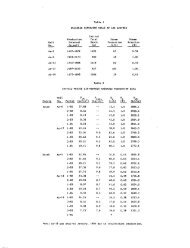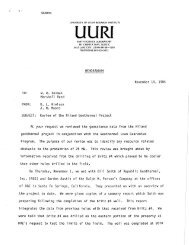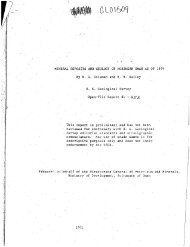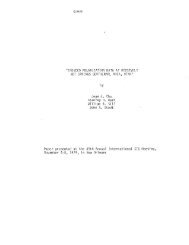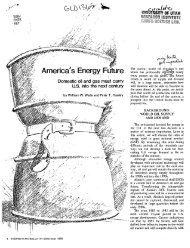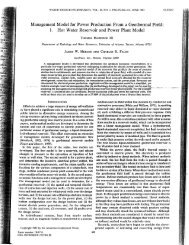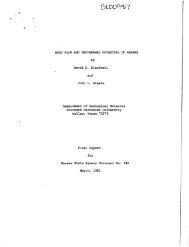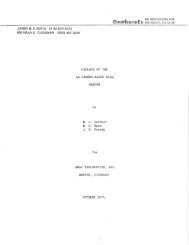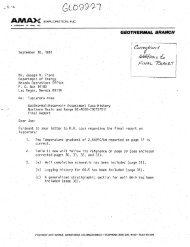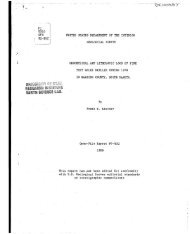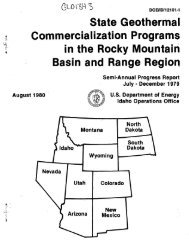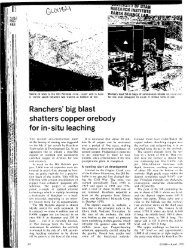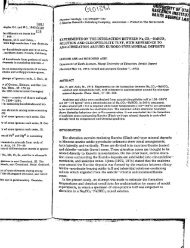Figure I Generalized map of the Wilbur Mining ... - University of Utah
Figure I Generalized map of the Wilbur Mining ... - University of Utah
Figure I Generalized map of the Wilbur Mining ... - University of Utah
You also want an ePaper? Increase the reach of your titles
YUMPU automatically turns print PDFs into web optimized ePapers that Google loves.
gravity signal is a rapid but Irregular 5 pgal increase<br />
beginning on day 086. This increase in<br />
gravity occurs over an 18 hour period which coincides<br />
precisely with <strong>the</strong> duration <strong>of</strong> <strong>the</strong> only significant<br />
rainfall In this 38 day data segment.<br />
Analysis <strong>of</strong> rainfall effects in barometrically<br />
adjusted gravity residuals is simplified by <strong>the</strong><br />
fact that <strong>the</strong>re is a slight decrease in barometric<br />
pressure directly associated with <strong>the</strong> release <strong>of</strong><br />
mass from <strong>the</strong> atmosphere. This decrease in<br />
pressure equals <strong>the</strong> weight per unit area <strong>of</strong> <strong>the</strong><br />
released mass. If we let Ag represent <strong>the</strong> gravitational<br />
attraction <strong>of</strong> a sheet <strong>of</strong> water <strong>of</strong> thickness<br />
equal to <strong>the</strong> depth <strong>of</strong> rainfall, <strong>the</strong>n it can<br />
be shown that <strong>the</strong> barometric pressure correction<br />
used to produce <strong>Figure</strong> Id contributes an amount<br />
-Ag to <strong>the</strong> residual gravity signal starting at <strong>the</strong><br />
time <strong>of</strong> <strong>the</strong> rainfall. Thus <strong>the</strong> net result <strong>of</strong> rainfall<br />
on barometrically adjusted gravity is simply<br />
to produce an apparent change by an amount -Ag if<br />
<strong>the</strong> sheet <strong>of</strong> water comes to rest above <strong>the</strong> gravimeter,<br />
or +Ag if <strong>the</strong> sheet lies below <strong>the</strong> gravimeter.<br />
In both cases, <strong>the</strong>se changes vanish as<br />
<strong>the</strong> water in question drains away from <strong>the</strong> vicinity<br />
<strong>of</strong> <strong>the</strong> gravimeter. Considering <strong>the</strong> terrain<br />
at The Geysers we would expect a zero change in<br />
<strong>the</strong> present case, or, at most, a change <strong>of</strong> +2<br />
ugal. Thus <strong>the</strong> 5 ygal observed change appears to<br />
be a spurious effect, most likely due to tilt.<br />
That tilt influences gravity measurements is<br />
a direct consequence <strong>of</strong> <strong>the</strong> vector nature <strong>of</strong> <strong>the</strong><br />
gravitational field. If one assumes that a gravimeter<br />
tilted by an angle 6 frora <strong>the</strong> local<br />
vertical simply raeasures <strong>the</strong> component gcos9, <strong>the</strong><br />
<strong>the</strong>oretical tilt response to lowest order in 8 is<br />
-1/2 pB^ or -4.6 x IO""* ugal/uradian^; i.e., <strong>the</strong><br />
gravimeter will read a maximum value when aligned<br />
with <strong>the</strong> vertical. This, however, is not <strong>the</strong><br />
case for <strong>the</strong> cryogenic gravimeter. The magnetic<br />
field geometry currently used to levitate <strong>the</strong><br />
test mass inside <strong>the</strong> instrument causes <strong>the</strong> tilt<br />
response to have a larger magnitude and opposite<br />
sign compared to <strong>the</strong> naive estimate. The actual<br />
tilt response <strong>of</strong> The Geysers instrument is<br />
+ 5.9 X 10-"* Mgal/pradian^. Thus <strong>the</strong> gravimeter<br />
reads a minimum value when vertical and deviations<br />
frora <strong>the</strong> vertical will tend to Increase <strong>the</strong> apparent<br />
value <strong>of</strong> g. Tilts <strong>of</strong> 40 yradians (1 ugal)<br />
would be observable and tilts <strong>of</strong> 100 yradians<br />
( 5.9 ugal) would be sufficient to explain events<br />
such as seen in <strong>Figure</strong> Id. The planned automatic<br />
leveling system should limit tilt to less than<br />
10 uradian (0.06 ugal).<br />
In spite <strong>of</strong> <strong>the</strong> problens in Interpreting <strong>the</strong><br />
two rapid changes in gravity in this record, <strong>the</strong><br />
general trend <strong>of</strong> <strong>the</strong> gravity residual In <strong>Figure</strong> Id<br />
shows a slow decrease <strong>of</strong> 4,5 ± 0.5 pgal over <strong>the</strong><br />
38 day segment. Extrapolating this trend yields a<br />
rate <strong>of</strong> decrease In gravity <strong>of</strong> 43 ± 5 wgal per<br />
year, which is in close numerical agreement with<br />
<strong>the</strong> average rate <strong>of</strong> decrease <strong>of</strong> 46 + 7 ygal per<br />
year Inferred from Isherwood's 1974 and 1977<br />
gravity surveys (Isherwood, 1977). Isherwood<br />
showed that this decrease could be explained by<br />
<strong>the</strong> mass deficiency generated by steam production<br />
over that two and one-half year period. The close<br />
agreement <strong>of</strong> <strong>the</strong>se two measurements is most likely<br />
521<br />
Olson, et al<br />
fortuitous, considering that Isherwood's data represent<br />
a yearly averaged effect, that <strong>the</strong> data<br />
were collected during two drought years, and that<br />
steam production has changed between 1977 and 1979.<br />
The agreement, never<strong>the</strong>less, indicates that <strong>the</strong><br />
cryogenic gravimeter raay be capable <strong>of</strong> producing<br />
results in one month that might take years to<br />
accomplish with conventional gravimeters.<br />
GEOTHERMAL IMPLICATIONS<br />
Although <strong>the</strong> data presented here are insufficient<br />
to yield new conclusions at this time regarding<br />
reservoir dynamics, <strong>the</strong>y do demonstrate<br />
that <strong>the</strong> cryogenic gravimeter has both <strong>the</strong> sensitivity<br />
and <strong>the</strong> stability required to produce new<br />
results. The continuous nature <strong>of</strong> gravity observations<br />
made feasible by this type <strong>of</strong> instrument<br />
enormously expands <strong>the</strong> interpretative power <strong>of</strong><br />
gravity studies. With <strong>the</strong> addition <strong>of</strong> a tilt<br />
stabilized platform, events which would o<strong>the</strong>rwise<br />
be obscured by long term averaging can be detected<br />
and events whose contributions to <strong>the</strong> total gravity<br />
change would o<strong>the</strong>rwise be indistinguishable can<br />
be separated and identified by <strong>the</strong>ir time signatures<br />
and correlations with o<strong>the</strong>r events.<br />
Even <strong>the</strong> short data segment presented here,<br />
despite its tilt uncertainties, indicates that we<br />
will be able to accurately observe <strong>the</strong> steady decrease<br />
in gravity associated with continuous steam<br />
production and thus provide <strong>the</strong> most direct available<br />
raeasure <strong>of</strong> reservoir recharge. The accuracy<br />
<strong>of</strong> <strong>the</strong>se estimates will be fur<strong>the</strong>r enhanced by our<br />
ability to separate out those sudden effects which<br />
appear to be unrelated to mass depletion. It is<br />
not unreasonable to expect that meaningful estimates<br />
<strong>of</strong> recharge may ultimately be obtained from<br />
as little as 90 days <strong>of</strong> gravity observations,<br />
<strong>the</strong>reby enabling study <strong>of</strong> seasonal fluctuations<br />
as opposed to multiyear averages.<br />
Fur<strong>the</strong>rmore, it may be possible to detect<br />
short term mass redistributions within <strong>the</strong> reservoir<br />
that could accompany changes In steam production<br />
or changes in reinjection, <strong>the</strong>reby yielding<br />
Information regarding <strong>the</strong> percolation-condensation<br />
cycle <strong>of</strong> steam within <strong>the</strong> reservoir. In<br />
addition, gravity events which are correlated<br />
with seismicity could provide clues regarding<br />
earthquake mechanisms at The Geysers and <strong>the</strong>ir<br />
possible relation to reservoir exploitation.<br />
ACKNOWLEDGEMENTS<br />
We thank Richard Dondanville and <strong>the</strong> staff <strong>of</strong><br />
<strong>the</strong> Geo<strong>the</strong>rmal Division, Union Oil Company, for<br />
<strong>the</strong>ir cooperation and assistance, especially<br />
during <strong>the</strong> installation <strong>of</strong> <strong>the</strong> site, and Richard<br />
Reineman for his technical expertise in fabricating<br />
<strong>the</strong> gravimeter. This work is funded by <strong>the</strong><br />
United States Geological Survey through <strong>the</strong> Extramural<br />
Geo<strong>the</strong>rmal Research Prograra under Grant<br />
USDI-14-08-0001-G-297.<br />
REFERENCES<br />
Goodkind, J. M. and Pro<strong>the</strong>ro, W. A. Jr., 1968, A<br />
Superconducting gravimeter. Rev. Sci. Instr.<br />
v..39, "p. 1257.



